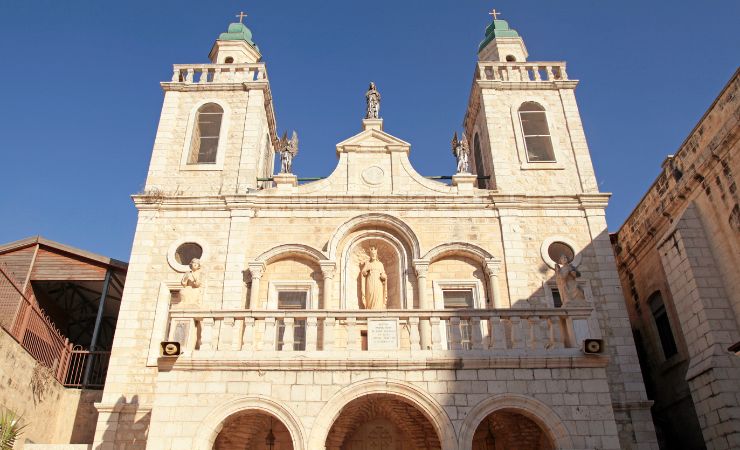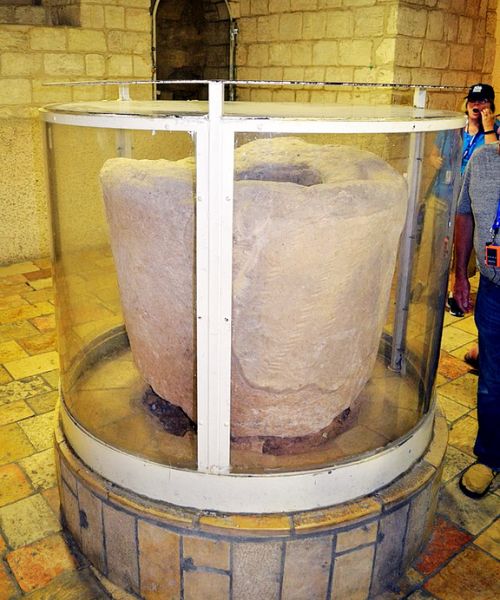The Wedding Church at Cana: The First Miracle
Introduction
The Wedding Church at Cana is believed to be the setting of Jesus Christ’s first miracle, where water was transformed into wine during a wedding feast. This event not only marked the beginning of Jesus’ public ministry but also underscored the sanctity of marriage and the importance of joyous celebrations.
Location
The Wedding Church is located in the modern-day town of Kafr Kanna in Israel, approximately 7 kilometers northeast of Nazareth.

Biblical Context
The Wedding at Cana is a significant event in the New Testament, specifically in the Gospel of John. This event is a pivotal moment that marks the commencement of Jesus’ public ministry.
The story unfolds in the small Galilean town of Cana, where Jesus, his mother Mary, and his disciples were attending a wedding feast. The celebration was in full swing when a problem arose – the wine ran out, a significant social faux pas in the context of a Jewish wedding feast. Mary brought this issue to Jesus’ attention, expressing her concern to him.
Despite initially expressing that his time had not yet come, Jesus acquiesced to his mother’s implicit request for help. He instructed the servants to fill six stone jars, typically used for Jewish ceremonial washing, with water. To the astonishment of the servants and the delight of the guests, the water was miraculously transformed into high-quality wine.
Jesus said to the servants, ‘Fill the jars with water’; so they filled them to the brim. Then he told them, ‘Now draw some out and take it to the master of the banquet.’
They did so, and the master of the banquet tasted the water that had been turned into wine.
This miracle, the first of Jesus’ signs, revealed his glory and led his disciples to put their faith in him. It’s not just about the transformation of water into wine, but it also symbolizes the transformation of the Old Covenant into the New Covenant in Jesus Christ. The water in the stone jars, used for ritual purification, represents the rituals of the Jewish law. The wine signifies the grace and truth that came through Jesus Christ, marking the dawn of the New Covenant.
This event also underscores the sanctity of marriage in Christian theology. Jesus chose a wedding feast as the occasion for his first miracle, highlighting the importance of this institution. The Wedding at Cana is thus commemorated in the Wedding Church at Cana, a site of pilgrimage for many, especially for married couples seeking blessings.



Is Kafr Cana the True Cana of the Bible?
The exact location of the biblical Cana, the site of Jesus’ first miracle, has been a subject of debate among historians and archaeologists. While the name Cana is still present in the Arab village of Cana near Nazareth, some scholars propose an alternative location – Kh. Cana, a mound situated 13 kilometers north of Nazareth.
Historical records, particularly the itineraries of Crusader-era pilgrims, suggest that these travelers visited Kh. Cana rather than Kafr Cana. This has led some to believe that Kh. Cana could be the actual site of the biblical Cana. E. Edwards from the University of Puget Sound led an excavation at Kh. Cana. The most significant discovery from this excavation was a cave, which Edwards suggests may have been associated with the veneration of the wedding miracle at Cana. However, despite certain anomalies in the cave, it remains uncertain whether it was indeed related to the miracle’s veneration.
Another possible location is on the western hill of Kafr Cana. Salvage excavations conducted at this site in 2004 revealed evidence of a 1st-century Jewish village. It is also possible however that this site and Kafr Cana were both parts of the ancient Cana.
Architecture of the Wedding Church at Cana
Built on a chapel that was built in 1879 by the Catholic Church, the current Wedding Church was constructed at the beginning of the 20th century. This site was chosen for its believed connection to the biblical miracle of Jesus turning water into wine.
Exterior Architecture
The exterior of the Wedding Church at Cana is a sight to behold. The church’s facade, adorned in pure white, resembles a cathedral in Zalburg, which was the hometown of Fr. Aegidius Geissler, the church’s first priest. The church is also symmetrical in design, echoing the symmetry in marriage. The exterior is intricately detailed with sculptures of angels.
Interior Architecture
The interior of the Wedding Church is divided into two levels: the upper church and the lower church. The upper church is home to a variety of beautiful decorations, including a portion of a Jewish synagogue dating back to the 5th or 6th century. The synagogue’s ancient mosaic even includes a dedication in Aramaic to the generous patron who commissioned it.
The lower church serves as a shrine and museum. It houses artifacts from the time of Jesus, including a winepress, multiple vessels and containers, and a jar believed to be one of the six used in the miracle of turning water into wine.
Architecture of the Wedding Church at Cana
Constructed in 1879 by the Catholic Church, this site was chosen for its believed connection to the biblical miracle of Jesus turning water into wine.
- Stone Jars: Archaeologists have found pieces of large stone jars similar to the ones described in the Gospel of John.
Ancient Synagogue: The discovery of an entrance portico of a synagogue from the first century and parts of a mosaic thanking the synagogue’s patrons.
- Jewish Ritual Bath: The presence of a Jewish ritual bath at the house indicates that it was a Jewish community, aligning with the biblical description of Cana as a Jewish village.
Some of the Sources Used:
Wedding Church at Cana – Wikipedia
Wedding Church at the Custodia Terra Santa
Cana (Kafr, Kanna): Franciscan Wedding Church, Jesus Turns Water to Wine, Jesus Heals, Nathanael | HolyLandSite.com
Nearby Sites
- Nazareth: Known as the childhood home of Jesus, Nazareth is a city replete with religious landmarks, including the Basilica of the Annunciation and the Church of St. Joseph.
- Mount Tabor: Identified by many as the site of the Transfiguration of Jesus, Mount Tabor offers stunning views and is home to the Church of the Transfiguration.
- Capernaum: Once a fishing village, Capernaum is now an archaeological site with ruins of ancient synagogues and the House of Peter.
- Sea of Galilee: Also known as Lake Tiberias, the Sea of Galilee is a significant biblical site where Jesus is said to have walked on water and performed other miracles.



